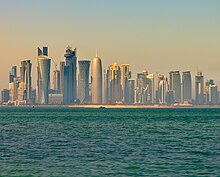
Back اقتصاد قطر Arabic Economía de Qatar AST Qətər iqtisadiyyatı Azerbaijani Economia de Qatar Catalan Ekonomika Kataru Czech Wirtschaft Katars German Economía de Catar Spanish اقتصاد قطر Persian Économie du Qatar French Economía de Qatar Galician
 | |
| Currency | Qatari riyal (QAR, QR) |
|---|---|
Trade organisations | WTO and GCC |
Country group | [3] |
| Statistics | |
| Population | |
| GDP | |
| GDP rank | |
GDP growth | |
GDP per capita | |
GDP per capita rank | |
GDP by sector |
|
Labour force | |
| Unemployment | |
Main industries | |
| External | |
| Exports | |
Export goods | Liquefied natural gas, Petroleum Products, Fertilizers, Steel |
Main export partners |
|
| Imports | |
Import goods | Machinery and Transport Equipment, Food, Chemicals |
Main import partners |
|
Gross external debt | $168 billion (31 December 2017 est.)[12] |
| Public finances | |
| Revenues | $297.70 billion (2022) |
| Expenses | $208.70 billion (2022) |
| |


The Economy of Qatar is one of the highest in the world based on GDP per capita, ranking generally among the top ten richest countries on world rankings for 2015 and 2016 data compiled by the World Bank, the United Nations, and the International Monetary Fund (IMF).[15][16] The country's economy has grown despite sanctions by its neighbors, Saudi Arabia and the United Arab Emirates. Mainly because the country exports primarily to Japan, South Korea, India and China, making the sanctions effectively redundant as neither Saudi Arabia nor the United Arab Emirates have imposed trading penalties such as tariffs or embargoes on any of these countries for trading with Qatar, or offering incentives such as discounts for their own energy exports to reduce Qatari exports.
Petroleum and natural gas are the cornerstones of Qatar's economy and account for more than 70% of total government revenue, more than 60% of gross domestic product, and roughly 85% of export earnings. Qatar has the world's third largest proven natural gas reserve and is the second-largest exporter of natural gas.
- ^ "Qatar: Country data and statistics". IMF.org. International Monetary Fund. Archived from the original on 22 December 2019. Retrieved 9 September 2020.
- ^ "World Bank Country and Lending Groups". World Bank. Retrieved 13 February 2024.
- ^ "Qatar: Country data and statistics". datahelpdesk.worldbank.org. Retrieved 29 September 2019.
- ^ "Monthly Figures on Total Population". psa.gov.qa. Planning and Statistics Authority. Retrieved 15 August 2023.
- ^ a b c d e f g h "World Economic Outlook Database, April 2024". IMF.org. International Monetary Fund. Retrieved 4 May 2024.
- ^ "Real Estate Market Review, Qatar Q1 2023" (PDF). cushmanwakefield.qa. Cushman & Wakefield. Retrieved 18 August 2023.
- ^ "Human Development Index (HDI)". hdr.undp.org. HDRO (Human Development Report Office) United Nations Development Programme. Retrieved 4 December 2022.
- ^ Nations, United. "Inequality-adjusted Human Development Index (IHDI)". hdr.undp.org. HDRO (Human Development Report Office) United Nations Development Programme. Retrieved 4 December 2022.
- ^ "Labor force, total - Qatar". data.worldbank.org. World Bank. Retrieved 23 January 2020.
- ^ "Export Partners of Qatar". The Observatory of Economic Complexity. 2019. Retrieved 19 June 2021.
- ^ "Import Partners of Qatar". The Observatory of Economic Complexity. 2019. Retrieved 19 June 2021.
- ^ "The World Factbook". Retrieved 9 March 2018.
- ^ "Sovereigns rating list". Standard & Poor's. Retrieved 26 May 2011.
- ^ a b Rogers, Simon; Sedghi, Ami (15 April 2011). "How Fitch, Moody's and S&P rate each country's credit rating". The Guardian. Retrieved 28 May 2011.
- ^ "GDP per capita (current US$) | Data". data.worldbank.org. Retrieved 13 September 2017.
- ^ "Report for Selected Countries and Subjects". www.imf.org. Retrieved 13 September 2017.
© MMXXIII Rich X Search. We shall prevail. All rights reserved. Rich X Search